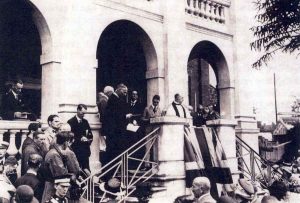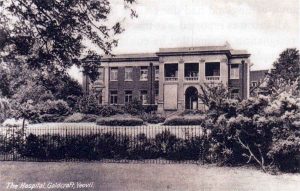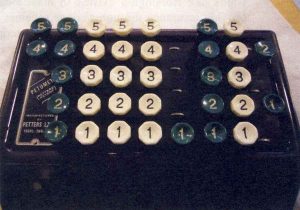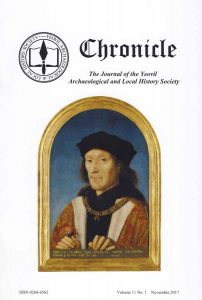
This article came from the Chronicle published November 2017. Pages 23-26
Yeovil General Hospital: “A History by Dr Charles Marsh 1880-1926”
Author: Jean Harper
Early in 2017, the committee of YALHS received a draft document outlining the history of Yeovil Hospital from its beginnings in 1858 up till the time its author, Dr Henry Marsh, retired in 1936. He had served as Senior Consulting Surgeon from 1889 to 1926 and as Honorary Secretary and Treasurer of the Board from 1924 until his retirement. The work is based on the Minute books of the committee meetings and the Annual Reports of the hospital board and consequently the narrative follows a fairly set pattern, dealing with the finances, staffing problems and day-to-day running of the hospital. The following is a summary of Dr Marsh’s account.
In 1858 Dr Warry and some friends instituted a dispensary in an old cottage in Kingston, Yeovil, which was run with the help of Mr Greenham and Mr Bennett. In the ensuing years, various alterations were made to the running of the institution and eventually (in 1862) the old private dispensary was taken over by a committee. Rules were drawn up and advertised and it was decided that Medical Officers would be appointed in January 1863. Messrs Warry, Aldridge and Bennett were appointed. Two amputations were deemed worthy of comment. In September 1863 Mr William Jeans of Martock was admitted suffering from a ‘wasted leg’. There follows a description of the operation to amputate the leg, carried out by Dr Warry and Dr Aldridge assisted by ‘several professional brethren’. The other amputation was carried out in 1866, when a patient was admitted suffering from cancer in both breasts. Dr Garland successfully amputated the right breast, ‘with every prospect of the woman’s recovery’. Subsequently Dr Coles presented a ‘handsome and complete’ set of amputating instruments.
In 1866 Dr Garland expressed the desire to see a suitable building erected and stated that if someone would give a piece of land he would undertake to raise £1,000 within 10 years. This suggestion was initially ridiculed by the committee, but Dr Garland accepted the challenge and a Building Fund was started. The death in Sidmouth of co-founder Dr Warry was recorded. At the Annual Meeting in 1867, additions to the Building Fund were reported, including a subscription of five guineas from the Duchy of Cornwall, and that amount ‘has been graciously and generously subscribed ever since’ [and still was as late as 1983 according to Dr John Guy in his commemorative booklet in 1983]. In January 1868 the Building Fund stood at £504..6..7 and, ‘through the liberality of several donors’, a piece of land at the top of Kingston between Preston Road and Ilchester Road, was purchased for £410 as a site for the Hospital. At the following meeting, the committee pledged to erect a ‘suitable building to serve as a Village Hospital and General Dispensary’ – a building which would be, ‘an ornament to the town and a monument to local liberality’. Four sponsors were named and a list of twenty-six donors with the amounts they had given followed. The management of the Hospital would consist of a President, Vice-President, Treasurer, Secretary and eight members selected from the subscribers, together with the Medical Officers. Mr D Vickery was appointed Honorary Secretary (and later, Mr J C Moore is named as Treasurer). The Matron was paid £10 per annum. Rules were again drawn up and it was decreed that ‘no person affected by disease the result of misconduct should be admitted, so, of course, anyone who met with an accident while under the influence of drink had to be, by the rules, rejected’.
In January 1871 designs for a ‘cottage hospital’ were invited giving details of the accommodation required for an outlay of £1,000. A Mr J Johnson from London was named as the successful applicant. Then in March, tenders for the building were invited and the work was given to Mr F Cox (£1195). By May the Foundation Stone was being laid by Miss Goodford and by December, Mr Cox expressed his intention to hand over the key by the end of the year. In January 1872 the building was temporarily put to use to accommodate some victims of the smallpox outbreak and in July it was reported that the architect had expressed his satisfaction with the building (Plate 20) [which was known as Fiveways hospital – Ed.]. With the new building, another set of rules was drawn up, dealing with the types of patient that could be admitted and what payment should be expected. Patients capable of doing so would be required to assist with household duties – washing and ironing, cleaning the wards etc., ‘as required by the nurse and subject to the approval of the surgeon’. Strict rules of behaviour were laid down – no swearing or cursing, or playing cards or smoking within the hospital. Any patient breaking the rules would be discharged immediately and not allowed to return. In 1883 the Annual Report made reference, for the first time, to three existing Trustees and the nomination of a further seven Trustees. In 1897 it was hoped that the events for the Queen’s Diamond Jubilee celebrations would provide some revenue for the hospital but later the committee expressed its ‘dissatisfaction’ that nothing had been done for them. In response Mr Philpott came forward and said he would donate £100 if £1,000 could be raised.
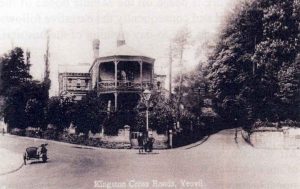
As always, money-raising efforts occupied the committee’s time and in 1898 much was made of the generosity of the ‘celebrated actor Mr Penley’, who was so pleased with the reception his play had received that he offered to give a return performance in aid of the hospital, which raised £50. Unfortunately, owing to his ill-health, he was unable to make any other contribution as he had promised. Also that year, a field known as Great and Little Northover was purchased for about £1,000, to be let for £60 per annum. This land was subsequently sold (in 1917) to Messrs Petter for them to extend their Westland Works area. In 1900 the Medical Officer suggested that wives and families of men on active service in the Boer War should be admitted to the benefits of the hospital absolutely free and treatment should be provided for two convalescing soldiers for a period of two months each, with the proviso that preference should be given to men of Somerset. At the same time the composition of the nursing team again came under consideration and it was decided this time that there should be one nurse with two probationers, that the probationers should receive no pay and they should buy their own uniforms. The author comments that ‘one could only express surprise that such a measure had been suggested and recommended by Matron’. A special meeting was called to sanction the purchase of 36 acres of meadow land at Limington known as Draycott Mead at a cost of £1,424 and providing a rent of £75.
In 1901, the Matron was dismissed following complaints about her rudeness and dereliction of duty and a new Matron was duly appointed to start in August. She proved to be well thought of by the medical staff and the various suggestions she made to improve the running of the hospital resulted in the decision to build a new operating theatre. The death of Mr J C Moore was recorded. He had been Honorary Treasurer for thirty-four years and it was resolved to commemorate his work by adding a wing to the hospital operating theatre, so another strip of land adjacent was acquired for the purpose. Plans were going ahead until it was announced that Mr Moore’s family disliked the idea, asking that a simple plaque be placed at the entrance to the hospital. This was accepted by the committee and the plaque was duly placed in the hospital entrance. It was decided that the new building should commemorate the coronation of King Edward the Seventh and the restoration of peace in South Africa. Subscriptions and donations were forthcoming and in May 1903 work began. It was expected that the building would be ready by the end of September but a disagreement arose about the type of flooring that should be used in the operating theatre. This delayed the work for quite a time and money was wasted changing the flooring half-way through. The new wing was finally opened on May 5th 1904.
In January 1904 the death of Dr Garland was reported very simply, in contrast to the ‘laudatory expressions poured out’ on the death of Mr Moore. The author of this history felt it necessary to pay tribute to Dr Garland as the founder of the hospital and to acknowledge all the work he had done subsequently. Throughout the year 1905 (and over four pages) the reports of the committee meetings were principally concerned with seemingly acrimonious discussions about the provision of church services in the hospital following a request from six Free Church ministers and the Roman Catholic priest that they be allowed to hold services as the Church of England had done since the hospital had been founded. What was finally decided is not clear. All that was reported was that the Honorary Secretary, Mr Henry Stiby, had ‘reluctantly’ tendered his resignation, saying that he could no longer endure the worry arising from the unnecessary wrangling and unpleasantness in which his office had involved him in the past year. The author makes a comment that implies that Mr Stiby was at least partly to blame for the wrangling.
In January 1909 a suggestion was made that a Nursing Home should be established and it was also suggested that a Home for private nurses should be provided. In June it was arranged to rent the house belonging to the YMCA to serve as a Nursing Home for private patients. At the Annual Meeting in January 1910 it was reported that the Nursing Home for private patients was in full swing and nurses had been engaged to send out to private cases. The need for an X-ray apparatus was raised and it was agreed that Mr Brett of the Medical Hall would provide the equipment at a charge and that the hospital would not install an apparatus in opposition for three years. Furthermore the Medical Staff were to guarantee Mr Brett that the receipts should not be less than £16 per annum. In 1912 the new National Insurance Act came into force and its effect on the hospital finances was discussed. Then in 1913 the further increase in numbers of patients made greater demands on the hospital resources. Many patients with less urgent maladies were having to wait two or three weeks for treatment. At the Annual Meeting in 1914 the committee was again asked to consider ways of extending the property to provide adequate accommodation for patients and nursing staff. After much discussion it was finally decided that it would be better to find another site and build a new hospital. In 1915 it was decided to insure the hospital against air raid attacks. The war then put all plans on hold, but early in 1916 the Kingston Manor Estate was offered to the hospital for £4,000, and in June the purchase of the Manor House and surrounding land was agreed. By July, one room of the building had been converted into an operating theatre.
No further action seems to have been taken until the Annual Meeting in 1918 when it was mooted that this would be a good time to go ahead with the scheme for the new hospital, but there was some doubt whether the Ministry of Munitions would agree to building while the war was still going on. During the next few years, until the hospital was finally opened in 1923, the committee meetings were frequently concerned with matters relating to the new building work needed. How to finance the work was a major consideration and strict limits were placed on the outlay. Suggestions were made that it should be dedicated as a War Memorial, but this was vetoed at a public meeting, in favour of a Public Library and a monument. The foundation stone was laid by the President of the Hospital, Col. G C W Heneage MVO DSO, in a public ceremony in June 1921 and the Prince of Wales was ‘humbly requested to perform the opening Ceremony’, which he did on 19th July 1923 (Plate 21). Prior to the official opening the hospital, `equipped with electric lighting and central heating’, accepted its first patients on December 16th 1922. The committee was proud to be able to invite certain interested parties to inspect ‘the splendid wards, the operating theatre and the spacious corridors which were in every respect up-to-date’. Following the opening ceremony, a marble tablet commemorating the event was placed in the corridor of the hospital, surmounted by a framed photo of HRH on the front steps of the building. Also during this period, there were several discussions about providing beds for returning ex-servicemen and their families and Bide’s Gardens were created. A general view of the new hospital is shown in Plate 22.
In March 1924 the death of Mr F W Mayo, who had served as Honorary Secretary and Treasurer for fourteen years, was recorded and Dr Charles Marsh was invited to take over temporarily, but in fact he stayed on until he tendered his resignation in 1936 on the grounds of ill-health. [He died in 1940.] From then on there is a change in the emphasis in the reports of committee meetings and Annual Reports – the account is less concerned with financial details and more with the innovations and improvements that took place over the years. In October, 1924 it was reported that the insurance for the building, contents and Engine and Dynamo house was settled at £43,500. It was also arranged to convert the greenhouse into a laundry and a site was selected for a new mortuary, as the only site currently available was a small cupboard next to the outpatients’ lavatory. Other alterations included the conversion of the stable and coach house at the Manor House into an X-ray department and nurses’ bedroom quarters. Yeovil Rotary provided a ‘splendid wireless set’, with attachments being provided for nearly all the beds in the hospital and nursing home.
In October 1925, Dr Marsh announced that he would resign as Senior Surgeon at the end of the year, having completed 46 years in that post and a bronze bust was commissioned to mark his service. During that year, a motor ambulance was provided for the town and neighbourhood. In subsequent years the hospital was periodically extended and modernised: a motor lawn mower and electric floor polisher were acquired, as were a fridge and new X-ray equipment. The old coke boiler, which had caused a lot of dust and dirt, was converted to oil. This was later replaced by two AGA cookers, when it was stated that it was difficult to retain suitable staff without modern appliances. An automatic mixing machine and blender was also supplied for the kitchen and a ‘wonderful Petter adding machine’ (Plate 24) was bought for the Secretary’s office. The electric lighting, which had hitherto been provided by a private plant, was considered unsatisfactory, and was now supplied by Yeovil Electric Light and Power Company. Repairs were constantly needed. For example, the operating theatre needed re-enamelling and the roof tiles on the outpatients’ department had become defective.
By 1932, Dr Marsh was suggesting that owing to the increase in the number of patients, extra probationers were required and that, as a result, more bedroom accommodation was needed. A temporary solution was found in the hire of rooms in nearby houses at a cost of 10/- per week and plans were put forward to build an extension over the entrance between the Nursing Home and the outpatients’ department. This was built and ready by July 1933, providing eight extra bedrooms and a bathroom, so there was no longer any need to hire outside rooms for the nurses. The next addition to the building was a wide glass veranda which was built over the inner side of the front entrance. In 1935, Dr Marsh informed the committee that the uncertainty of his health made his resignation as Honorary Secretary and Treasurer inevitable. He did, however, continue to serve for a few more months and set the machinery in motion for yet another, and larger, extension which would include a larger men’s ward, a special children’s ward, a Solarium for each floor, about a dozen side wards for private patients, five extra bedrooms for nurses, a secretary’s office, a casualty room and a surgeons’ dressing room. The builders were Messrs T Nicholls of Gloucester who were building the new County Offices at Taunton. The account closed with the statement ‘Proceedings commenced forthwith’.
Hits: 93
